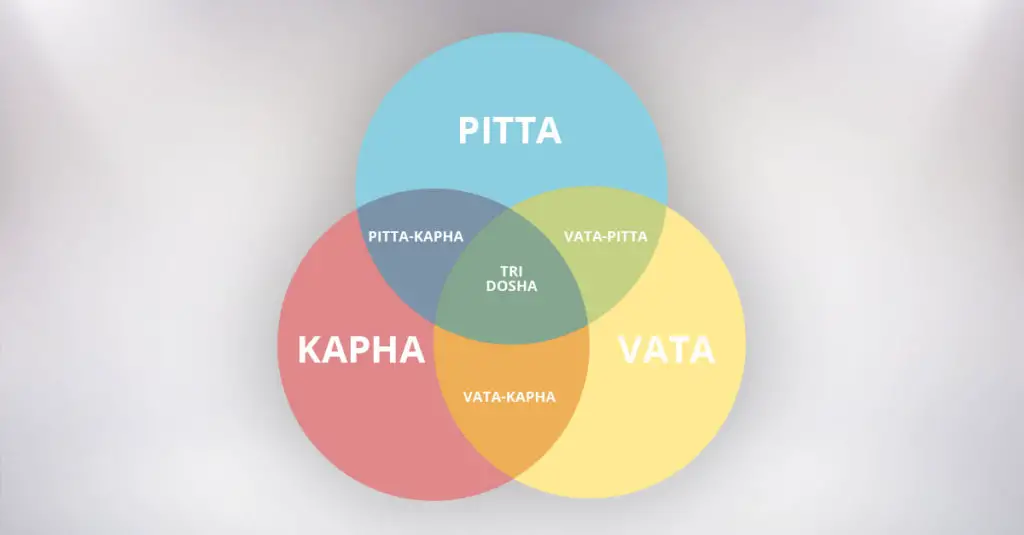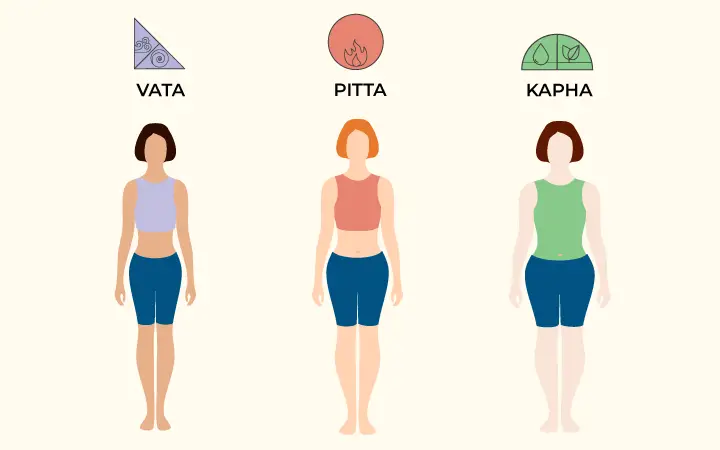Ayurveda Eating Principles To Balance Vata Pitta Kapha Doshas:
Jump To:

Food is the most comforting part of everyone’s life. Irrespective of what your food preferences are, the thought itself makes you feel good. It’s associated with every emotion that humans can express, festivals, religious customs, rituals and much more. But, the most consciously overlooked fact is health. In the Ayurvedic lifestyle, to eat mindfully, it is important to understand your body type and the Vata Pitta Kapha diet chart. Know Ayurveda body types, Ayurveda eating times. To balance water particularly, there is mudra for water retention and dehydration. Let’s get into the Ayurveda eating rules for the best health benefits.
The eating habits of people at large, cause most of their illnesses. Ayurveda, the ancient medical system, has a profound way to explain the human body types and help you with the right foods for a healthy life.
What Is Prakriti?

Ayurveda states, that what you should and shouldn’t eat depends on your body’s constitution or Prakriti. If your diet worsens your body constitution or Prakriti, you are bound to feel low on energy and trigger ailments. However, when you have a diet that suits your Prakriti, you automatically feel healthy and happy.
Prakriti is the ratio of three functional energies in the body. Also known as doshas, these energies are Vata, Pitta, and Kapha. Each of these doshas has specific traits.
Mostly, two of three doshas dominate in an individual. Pulse diagnosis or Nadi Pariksha can help diagnose the doshas dominating in your body.
Vata Body Type:
The Vata dosha is the air element and is responsible for all movement in the body.
A balanced Vata: Energetic, enthusiasm, creativity, and flexibility.
An unbalanced Vata: anxiety, irregular appetite, mild weight loss, constipation, interrupted sleep, bloating
Pitta Body Type:
The Pitta dosha is the fire element and is responsible for digestion.
A balanced Pitta: Intelligence and strong digestion.
An unbalanced Pitta: anger, jealousy, indigestion, migraines, bladder and kidney infections.
Kapha Body Type:
The Kapha dosha is the earth element and provides moisture to the skin and lubrication to joints.
A balanced Kapha: Calmness, thoughtfulness and loving.
An unbalanced Kapha: depression, laziness, heaviness, weak digestion, excess sleep, diabetes.
Ayurveda Diet Rules For All Doshas:
The most common issue that everyone experiences at some point is indigestion. While popping a tablet seems like the easiest way out, Ayurveda, or call it the yogic way of eating is a long-term plan, to keep indigestion at bay. Here are a few guidelines that ward off indigestion issues.
Eat Seasonal Food:
Since the cycle of seasons affects our predominant dosha, eating state, one must eat according to the seasons. For instance, one must have warmer foods during cold weather, as cold foods in the winter will inhibit our digestive fire.
What Time To Eat:
Eat larger meals between 10 AM and 2 PM.
After The Meal:
Post-meal walks with a 10 to 15-minute rest aids indigestion.
Why Do We Crave Sugar?

Sugar cravings are not always due to the liking of sweets. Ayurveda identifies six major tastes we need in our diet every day that is sweet, sour, salty, pungent, bitter and astringent. When we consistently eat the food of particular tastes, it causes health problems and also triggers cravings for unhealthy foods. For instance, fast food contains mostly sweet, sour and salty tastes. Consuming them regularly leads to sweet cravings.
How To Balance Vata Pitta Kapha Doshas?
Diet is a way to balance Vata Pitta Kapha doshas. Here’s a quick guide to the foods, the Vata Pitta Kapha diet chart, that balance your Prakriti. This can help you understand what and how much of everything you must eat based on your health needs.
Vata Dosha Diet:
- Fruits: All sweet fruits, fresh dates, figs, and raisins.
- Grains: Rice and wheat.
- Vegetables: Cooked vegetables, asparagus, sweet potatoes, pumpkin, less amount of leafy vegetables, beans and sprouts.
- Nuts: Nuts soaked in water and pumpkin seeds.
- Legumes: Lentils, moong beans, and soya.
- Dairy: Milk, fresh cheese butter and ghee.
- Oils: Sesame, olive, sunflower, and peanut.
- Spices: Black pepper, ginger, coriander, turmeric, asafoetida, garlic, clove and sesame seeds.
- Avoid Dry food, junk food, cold food, frozen food, large beans like kidney beans and peas.
Pitta Dosha Diet:
- Fruits: All sweet fruits, pomegranate, figs, and dates. Avoid sour fruits.
- Vegetables: Sweet and bitter vegetables, asparagus, cabbage, carrot, cauliflower, leafy vegetables, sweet potatoes, pumpkin, radish, sprouts, and zucchini.
- Grains: Wheat, rice, oats and all beans in a moderate amount.
- Dairy: Buttermilk, curd, milk, and ghee.
- Oils: Sunflower, olive, and coconut.
- Spices: Cinnamon, fennel, ginger, mint, coriander, turmeric and cumin in moderate amounts.
- Nuts: Soaked in water.
- Avoid Spicy, junk food, fried food, sour food, baked and fermented food.
Kapha Dosha Diet:
- Fruits: All fruits can be moderate.
- Grains: Barley, ragi, corn, oatmeal, millets, and beans.
- Vegetables: All leafy vegetables, cabbage, cauliflower, peas, radish, wheatgrass, and sprouts.
- Spices: Ajwain, asafoetida, basil, clove, cumin, curry leaves, fenugreek, garlic, ginger, pepper, pippali and turmeric.
- Dairy: Buttermilk, goat milk, and soya milk.
- Oils: Sesame oil in less amount & olive oil.
- Nuts: Sunflower seeds and flax seeds.
- Others: Honey
- Avoid Sweets, chocolates, pastries, cold drinks, milk products except for buttermilk and milk cake.
Eating Like a Yogi – The Vedic Ayurveda doesn’t ask you to stop eating what you like. It is more about what your body is designed to consume and needs. If you are a non-vegetarian, you must balance the amount of meat and source it with great care, yet follow a vegetarian diet largely.
While there are varied perspectives on what feeds the body and the soul, developing a diet that reflects your ethics, personality and physical needs can be quite challenging. Nonetheless, when you choose to ‘eat like a yogi’ you’re bound to develop awareness about what you eat. It’s worth spending time educating yourself about not just the diets you may follow but also the origins and properties of the food you buy. As you explore the parameters of a yogic diet, allow for some flexibility and eat the right way. “Yoga is about freedom, including freedom from your own strong beliefs and ideas. So, eat what you like but follow what is right!”
